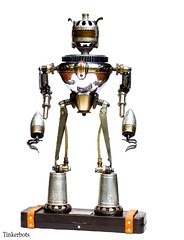Generally, bots have proved effective operating in high-radiation environments, but Japan’s nuclear crisis poses new challenges.
As workers race to stave off further melting at the Fukushima Daiichi nuclear reactors in Japan, several robots there are waiting on the sidelines for an opportunity to help. Questions remain, however, regarding how these units might assist in an ongoing emergency at a site contaminated with radiation and deluged with tons of corrosive seawater.
Concrete pump trucks sprayed about 130 tons of water into Daiichi’s No. 4 reactor on Wednesday, Japan’s Nuclear and Industrial Safety Agency (NISA) reported (pdf). Meanwhile, Tokyo Electric Power Company(TEPCo) injected about 35 tons of seawater into the spent fuel pool of the No. 3 reactor to keep the fuel rods there from overheating, according to NISA, which also observed “slightly blackish” smoke generated from the building housing that reactor. Seawater is also being injected into the No. 1 reactor as well as the spent fuel pool of the No. 2 reactor.
TEPCo summoned a small corps of military-grade robots last week from iRobot Corp. in Bedford, Mass. Japan’s Mitsui Engineering & Shipbuilding Co. last week sent its Disaster Monitoring Robot, or Moni-Robo, to the Daiichi site as well. Other robotics companies, including Canada’s Inuktun Services, are also fielding inquiries about how their technology might be of use. Each of the robots of interest moves on tracks and features a mechanical hand that can be used to lift and manipulate objects.
The roles that robots might play in Japan will depend upon the emergency responders’ priorities, whether this includes handling intensely hot or radioactive materials or, later removing sludge from the site or drilling core samples to determine how deeply radiation may have penetrated the facility’s walls and floor, says William “Red” Whittaker, a Carnegie Mellon University robotics professor and director of the Field Robotics Center at the school’s Robotics Institute in Pittsburgh. Whittaker and several Carnegie Mellon colleagues built robots in the late 1970s and early 1980s to inspect and perform repairs in the basement of Three Mile Island Nuclear Generating Station following the near meltdown there in 1979.









